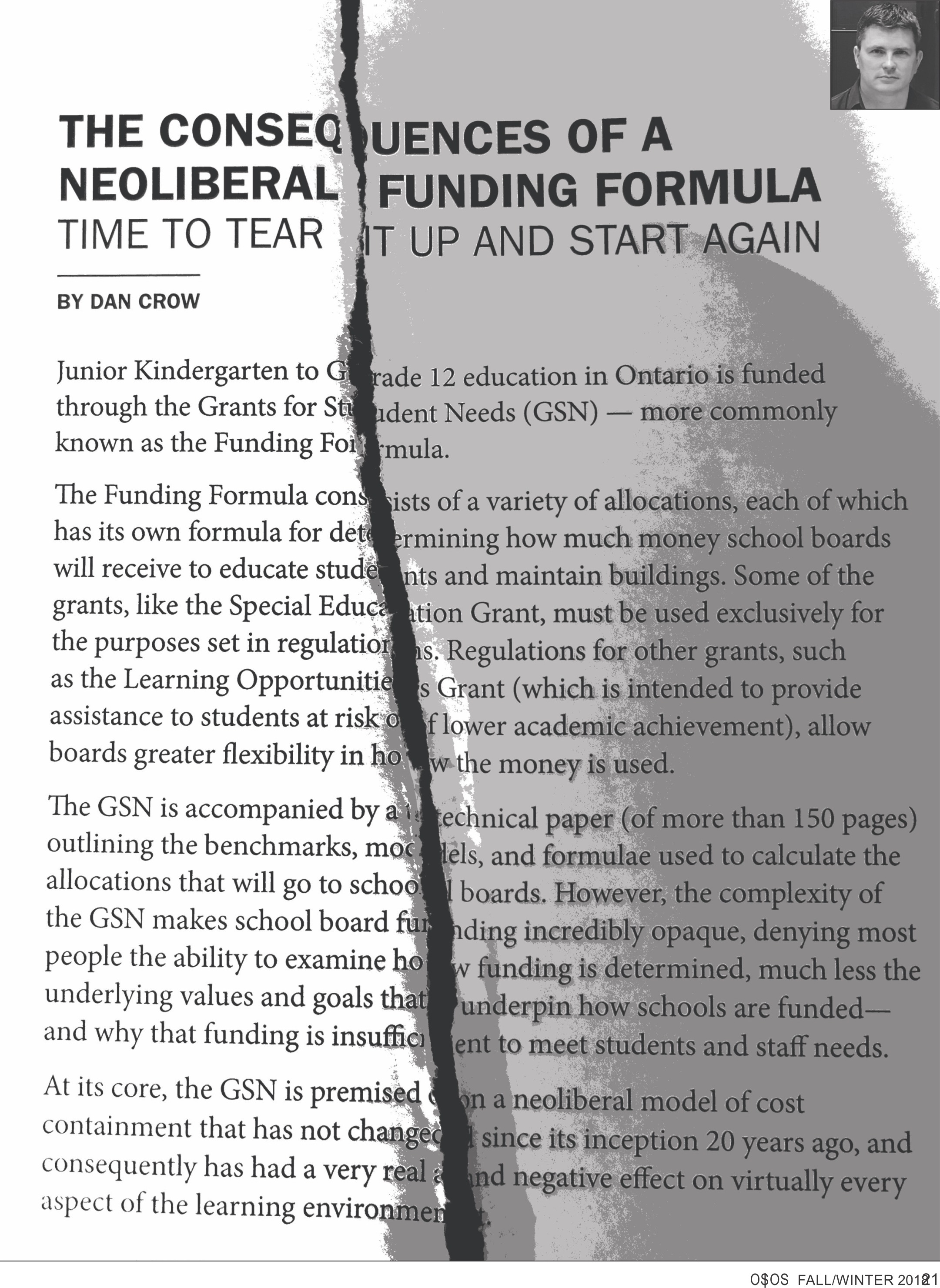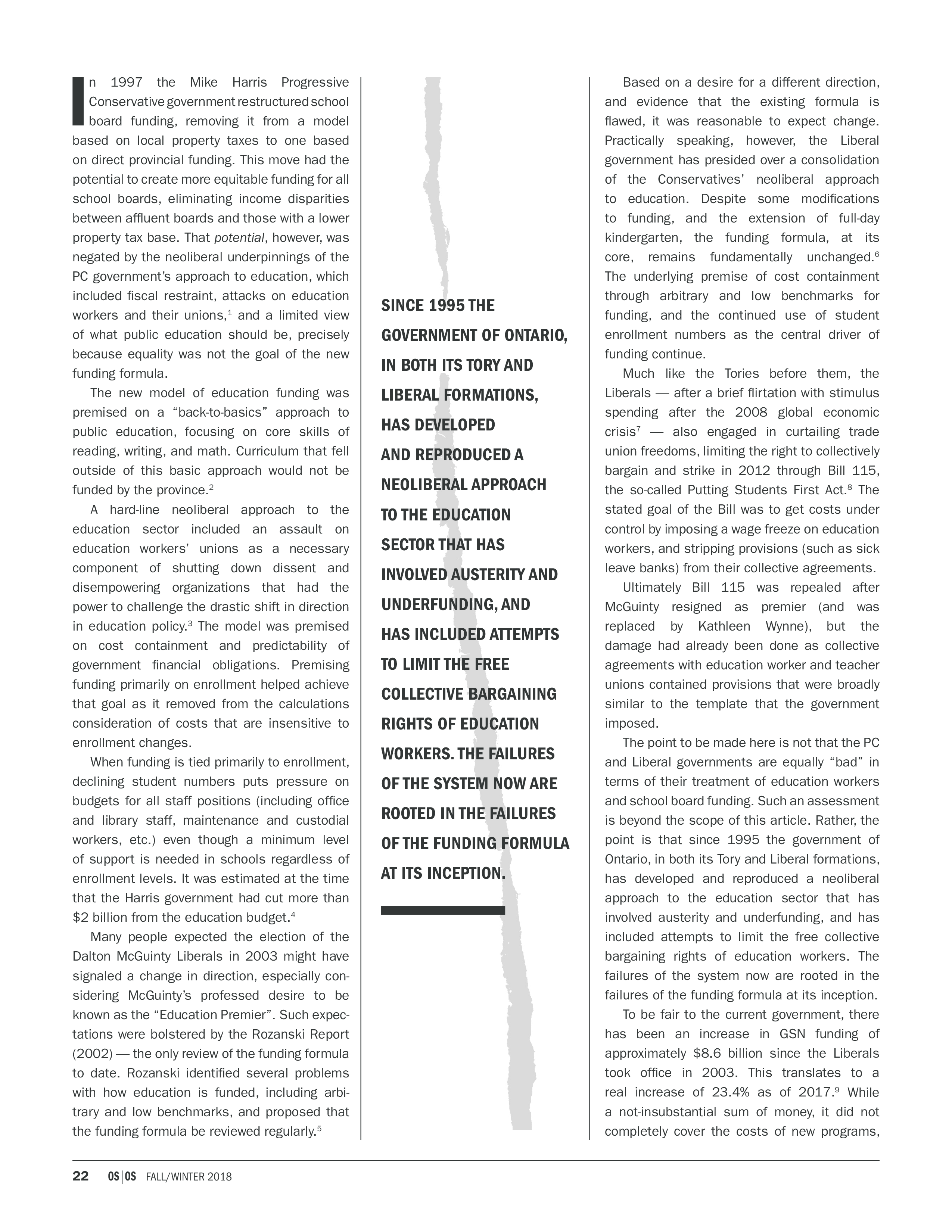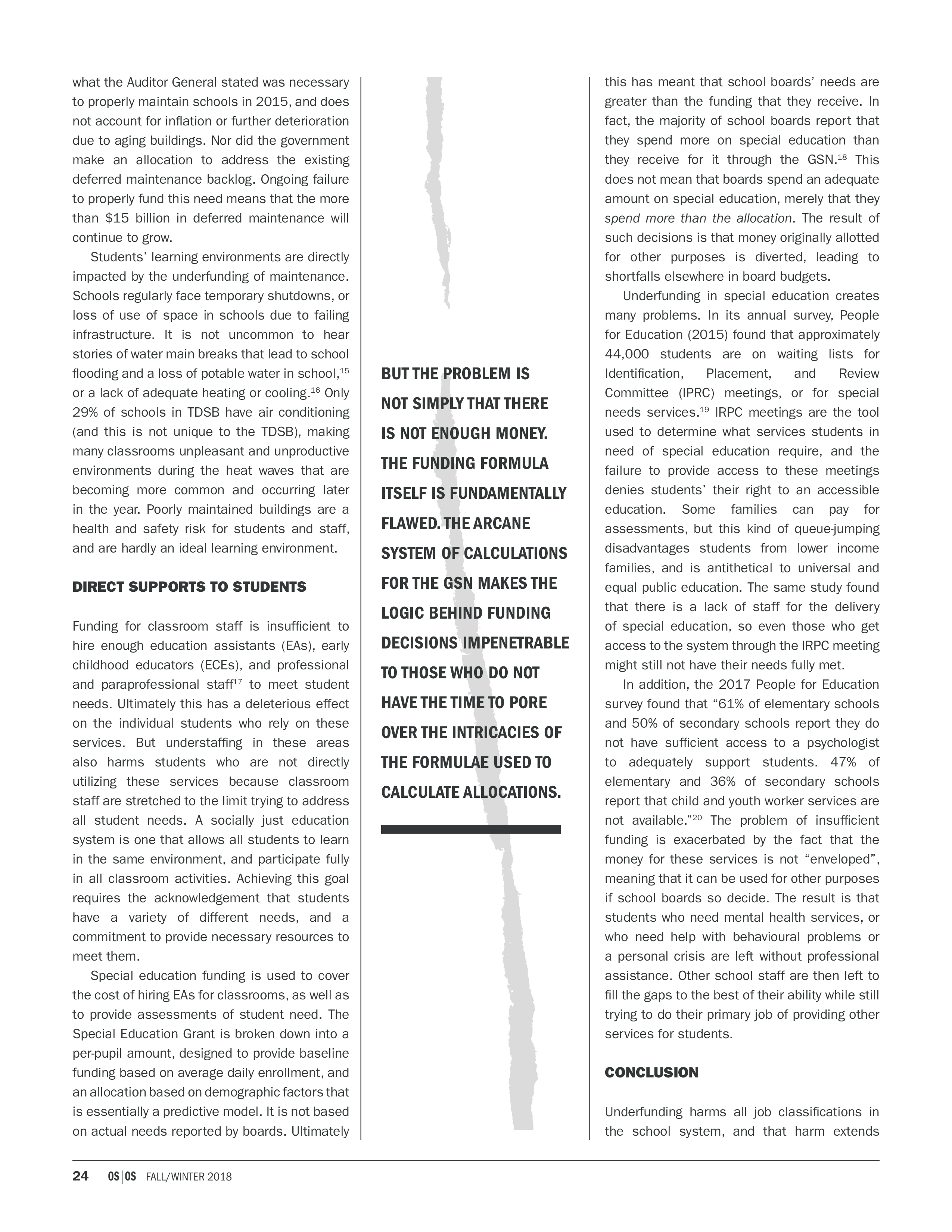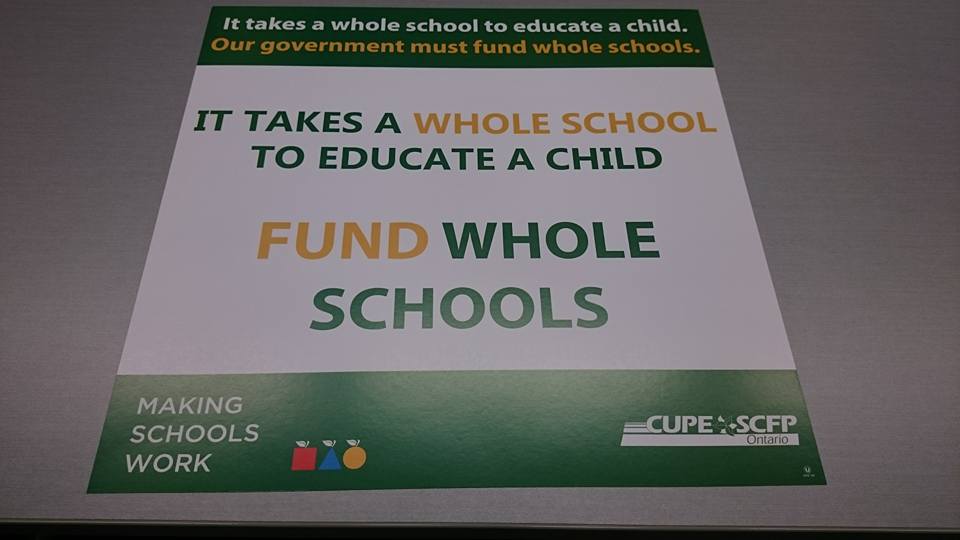Without a doubt! We have a broken funding formula and inadequate funding of Special Education which translates into insufficient staffing of Special Education Assistants and a lack of resources, programs, and professionals to provide for the needs of our Special Ed. students. As a result we have chaos in our schools with staff so stretched that most of our students, those with special needs and those without, are not getting what they need.
I’ve come to believe that the only ones who may be able to affect change in our schools are the parents; so please, please, please, contact your MPP and speak out in support of the changes we need to ensure that ALL of our students receive the education that they deserve!
Please read the article below and join in the fight for much needed improvements in Ontario’s education system……
Vicky Evans,
President, CUPE Local 4148

A brief comment in the news last week caught my eye. Pat, a retired school teacher, asked Premier Kathleen Wynne about violence in our schools, claiming teachers and students are frightened for their safety.
It was frankly satisfying to hear that question asked. You may recall it was five years ago when Lambton Shield first broke the shocking story about the outrageous state of Ontario’s education system HERE. And since that time the subject has been broached by some big names; CBC News, Global TV, the Toronto Star… heck Kathleen Wynne was even asked a question about it in Question Period last year.
Despite the press, the Ministry of Education has done little except fiddle while our education system burns.
This includes schools right here in our own little corner of utopia, Sarnia Lambton.
Why has no one done anything? Why do our Toronto politicians, who caused most of this mess, not have the intestinal fortitude to fix it?
Sigh. As always, if we want something done, we’re going to have to do it ourselves.
The first step is exposing what exactly is going on. And it ain’t pretty. Here, have a listen.
“Most people would be stunned at what is happening in our schools,” a teacher with more than 25 years experience told me. “Think of what elementary school was like when you were a kid. It’s nothing like that today,” said another.
Wowza. If that sounds pretty major, hold on, its about to get worse.
I’ve spoken with close to 100 people; most of them teachers but also principals, school kids, and parents. I’ve received emails from teachers all over Ontario, probably from every school district in Southwestern Ontario.
And son of a gun, they all tell the same story.
We learned last time that very little “teaching” goes on in Ontario’s elementary schools, it’s mostly babysitting. Let’s see what teachers are saying about violence in our schools.
Ladies and Gentlemen, here is the public school system you are sending your children to:
—Teachers are told to “f**k off” and threatened on a daily basis, with little or no punishment given.
—Students steal and destroy things from the teacher’s desk or their fellow students, all with no repercussions.
—Ontario teachers are hit, punched and bit at school, with little, if any, discipline for the assailant. And certainly no apology.
—Teachers have scissors and chairs thrown at them. SCISSORS! In any other place in Ontario that would get you arrested, in Ontario schools it gets you returned to the same teacher’s class the very next day.
—Teachers have witnessed innocent kids get punched, hit and slapped by “bad kids”. One student smashed little girl’s head off the wall so hard it nearly broke her jaw. Why did he do this? Because he didn’t like the fact that the teacher opened the window. That student is still in the same class as that little girl.
More than one teacher has told me they had to lock their classroom door and stand against it while a student was trying to get in, saying he was going to beat up/kill another student in the class.
If a child doesn’t want to come in off the playground after recess, they don’t have to. Schools have a hands-off policy so no one will be carrying little Billy into the school. The school could call home but parents were told by the government to butt out of education long ago, so parents now believe their bad child is the school’s problem. What to do? The school will assign staff to simply stand and watch them.
What if little Billy decides to run away? (This is a daily event in some classes) No one from the school can stop them. If the student leaves school property, the school calls the police. (This is a weekly and sometimes daily event in many schools). Since most schools are located on a street or roadway of sorts, isn’t there a chance a runaway grade one or grade two student might get hit by a car? Kidnapped? Lost? Of course. But apparently that’s not the Ministry of Education’s worry.
What a great system!
Seriously, I want you to tell me if that sounds like a safe place to work?
Is this the kind of school you thought you were sending your kids to?
Oh, and exactly how much learning do you think kids in these schools are getting?
Every school does not have all these elements of course, but teachers were almost unanimous in saying that schools all have at least some of these situations. MANY more than most parents know.
Yes right here in Lambton County.
Still not convinced?
The Elementary Teachers Federation of Ontario (ETFO) just released its Workplace Survey Results, and guess what? Their findings back up mine 100%.
- 70% of elementary teachers witnessed violence or have been a victim
- 79% say the number of violent incidents has risen
- 75% say the severity has increased
- 84% of teachers say it has negatively impacted teaching
EVERYTHING we have been saying!
Most people would be stunned at what is happening in their child’s school.
Our dear leader, Kathleen Wynne, said at the Ottawa town hall meeting that any violence at school is “unacceptable.” Apparently, she isn’t looking very hard. (Would someone please be a dear and send her a copy of this column?)
If violence is unacceptable why are teachers, students, and educational assistants (EA’s) across the province experiencing it?
What happened to the Harassment Policy the Ontario government was so proud of a few years ago. Does it not apply to Teachers or our children?
What about the rule of law? Is there some sort of invisible boundary line surrounding schools that says normal laws don’t apply here? Feel free to hit, kick, assault and threaten anyone, no charges laid?
Name me ANYWHERE else in Ontario you could do this?
You can bet you’d be in handcuffs if you treated Kathleen that way.
But our teachers and our children don’t have a group of police officers surrounding them all day.
Many teachers tell me that the EA’s in the classroom bear the brunt of this violence. They don’t have police escorts either.
So why are we letting this happen?
Several of the teachers I talked to said things really got worse about 10 years ago or so. I’m not sure what changed, and I’m all for trying out new ideas in our school system, but I think the verdict is in. The current system is a complete disaster.
Isn’t our Premier all about science? I would say 10 years of evidence screaming at you seems like it’s a pretty open and shut case that things are failing. So why isn’t the Premier and the Minister of Education doing something about this? If they don’t know the health and safety of thousands of students and teachers are being ignored every day, then they are either incompetent or ignoring it.
So what to do? David Martin from the Durham teachers union was interviewed by Global News a while ago and he hit the nail on the head. He said nothing will change until the public is aware of what is going on.
Dave is a wise man.
Our teachers and EA’s can’t do it alone. The union can’t do it alone. The media, Town Halls and Question Period can’t do it alone. But with a big push from all of us, we can get it done together.
I don’t want my daughter to come home from school tomorrow with a broken jaw. I don’t want her to see her teacher get stabbed with a pair of scissors. Let’s make the government hear us. Here are some practical steps:
—Share this article on Facebook (and any others you find, this isn’t just the Matt show.)
Know any teachers or parents with kids in school? Ask them to share it too. I know it sounds lame: “Let’s talk about it on social media”—but there’s only one thing the Ministry of Education fears, and it’s a good old-fashioned parental revolt. An angry social mob of parents demanding change.
“Nothing will change until the public is aware of what is going on.”
—Email your MPP. I’m not sure there’s much they can do at the moment, but we might as well let them know we’re coming so they can get on our side.
Any teachers or school staff who have a story to add to the above, I would love to hear from you. All emails will be kept confidential. mmceachran@gmail.com







